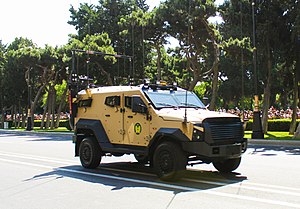| Plasan SandCat | |
|---|---|
 Plasan SandCat at the military parade in Baku. | |
| Type | Light armoured vehicle |
| Place of origin | Israel |
| Service history | |
| Used by | See Operators |
| Wars | Mexican drug war[1] Second Nagorno-Karabakh war |
| Production history | |
| Designer | Nir Kahn[2][3] |
| Designed | 2004 |
| Manufacturer | Plasan / Oshkosh Corporation / IBN Industrias Militares/IBN Military Industries |
| Produced | 2004-present |
| No. built | around 700 |
| Specifications | |
| Length | 5.94 m (4th Generation M-LPV)[4] |
| Width | 2.315 m (91.1 in)(4th Generation M-LPV) |
| Height | 2.54 m (4th Generation M-LPV) |
| Crew | up to 10 (variant dependent)[4] |
| Armor | steel/ceramic/Kevlar; protection level to suit requirement |
Main armament | Remote weapon station (optional) |
| Engine | 6.7 L Power Stroke diesel V8 (6.4 L in early variants) [4] |
| Payload capacity | up to 2,109 kg (generation and variant dependent) |
| Transmission | Ford Torqshift six-speed automatic (five-speed in some early models) |
| Suspension | coil springs and shock-absorbers at the front and leaf springs and shock-absorbers at the rear. Uprated as required (second generation had a Plasan-designed coil spring and trailing arm rear suspension) |
| Ground clearance | 280 mm (4th generation M-LPV) |
| Fuel capacity | 150 litres (4th generation) |
Operational range | 500-550 km (3rd and 4th generation) |
| Maximum speed | 110 km/h (4th generation) |
The SandCat (Hebrew: פלסן קרקל)[5] is a composite armored vehicle designed by the then Plasan Sasa (now Plasan) of Israel. The SandCat was shown publicly for the first time at AUSA during October 2005. The latest models were shown for the first time at Eurosatory 2018. The SandCat is based on a commercial Ford F-Series chassis. Approximately 700 SandCats have been produced since 2004, and while Plasan has never released complete details, these are known to be in service with at least 16 users across five continents, and in a wide variety of roles that range from Police/internal security to combat/patrol.[4]
- ^ Medellin, Jorge (2017-11-06). "Llegan los Sandcat a Tamaulipas para combatir al narco". Estado Mayor (in Spanish). Archived from the original on 2021-09-14.
- ^ חדשות הרכב מישראל ומהעולם, הכל על מכוניות (in Hebrew). Motocar. Archived from the original on 2009-06-17. Retrieved 2012-07-04.
- ^ "Across the desert in the Plasan SandCat". Top Gear. 2016-08-09. Retrieved 2016-08-09.
- ^ a b c d "SandCat". 2018-06-27. Retrieved 2018-08-31.
- ^ ""Sand cat" - All-Protected Combat Vehicle from Plasan Sasa". defense-update.com. Archived from the original on 2018-04-28. Retrieved 2017-01-23.